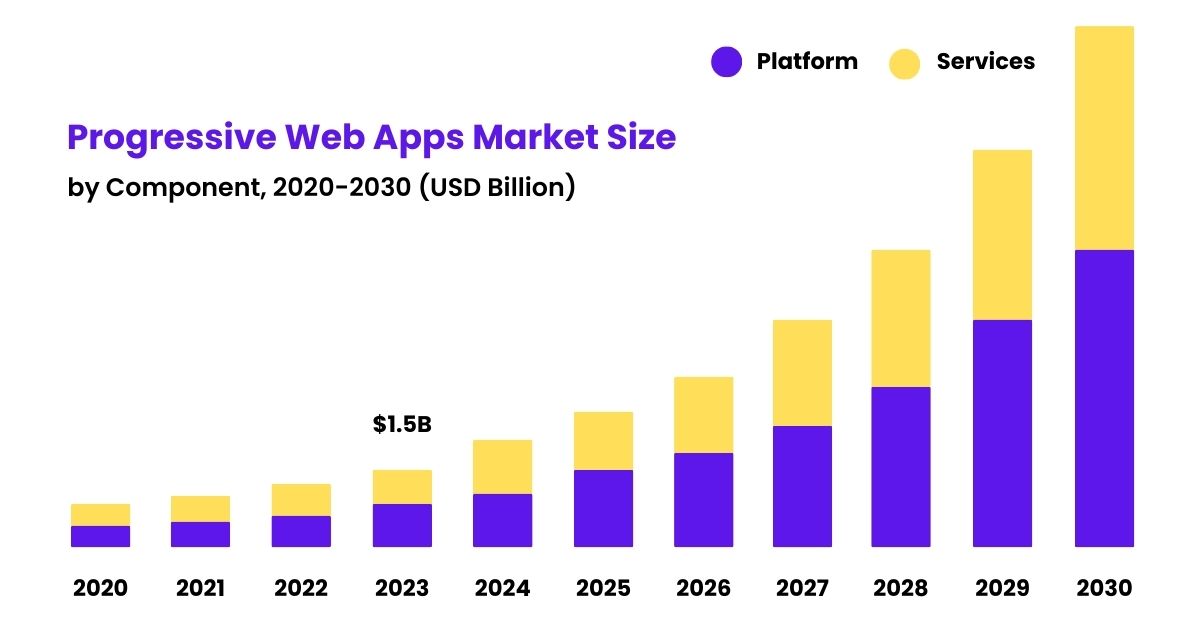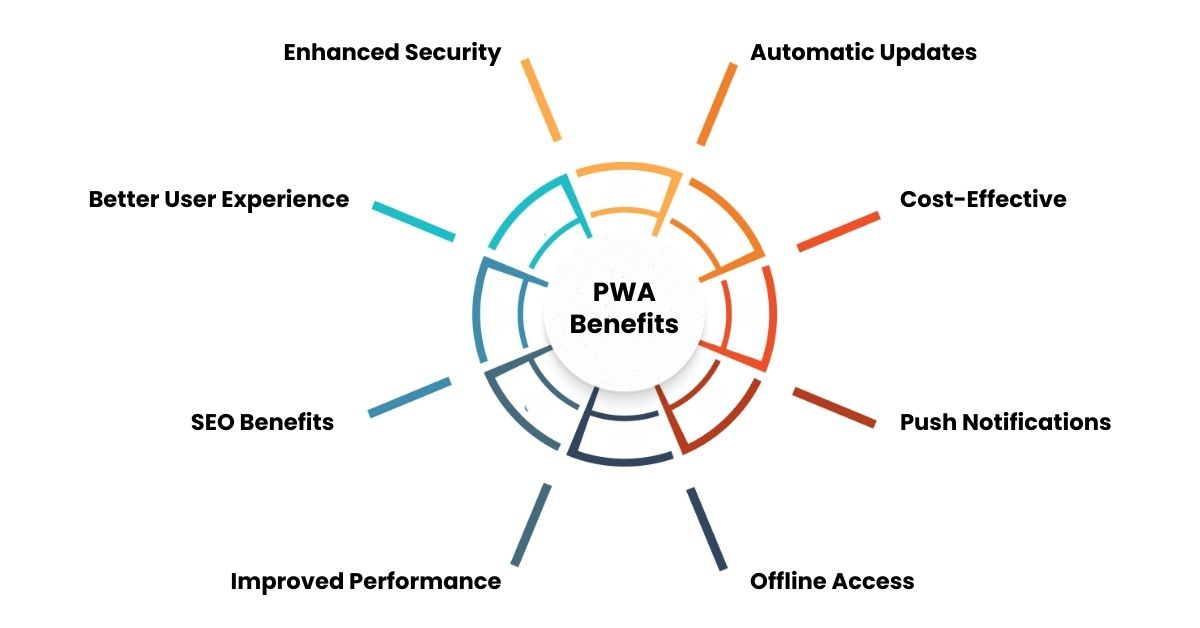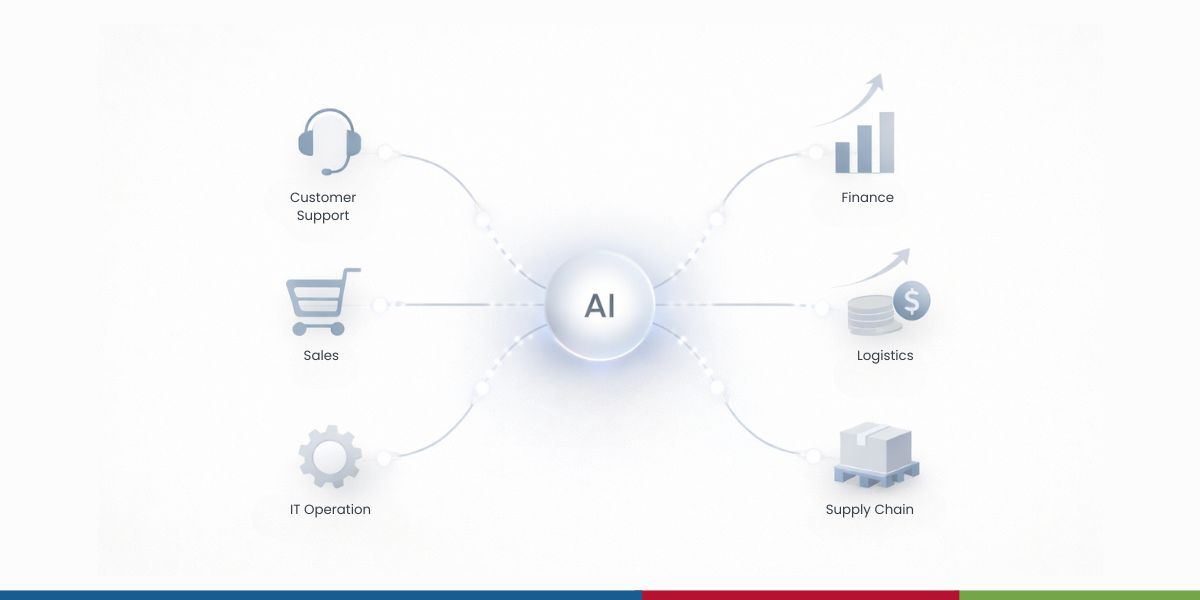Progressive Web App (PWA) Market Trends (2025)

4 min read | By Postpublisher P | 14 November 2024 | Software trends
By 2025, the market size of Progressive Web Apps is expected to be valued at USD 2.8 billion.
( Source: Researchnester)
The Progressive Web Apps (PWAs) are growing fast as a market because companies want to engage with customers in faster, and cost-efficient ways. PWAs provide a user experience similar to those of applications, but directly on the browsers – for instance, offline capabilities, rapid loading, and no necessity for app download. Demand will grow exponentially by 2025, as reflected through a rise in mobile usage and increasing technological development.Areas like retail and travel, as well as social media firms, will introduce PWAs to add more users, especially in areas where connectivity is limited for an efficient solution for modern digital interactions.
Exploring Market Trends 2025 in the Rise of Progressive Web Applications
Progressive Web Apps development are the key to adaptive web development in 2025. PWAs are fast and easy to use on any device, even without an internet connection. PWAs are cost-effective because they use a single code for both web and mobile applications. PWAs enhance user experience, and this leads to increased ranking on search engines. With the trend that businesses are shifting more towards modern, efficient solutions in the digital space, PWAs have really become very important tools for digital transformation, establishing themselves as the best technology for PWA development.
Popular Progressive Web Apps of Today
Progressive Web Apps, as well as the amalgamation of web and app features, are revolutionising user experiences. Loads extremely fast, even on slow connections- Twitter Lite; lets users easily save images- Pinterest; and allows booking a ride right in a browser- Uber. Utilising the best web development frameworks like Ionic, AngularJS, or React, developers build engaging PWAs offering offline and push notifications access. The main benefits of PWAs include offering a very seamless installation onto the home screen and preserving performance through standard web technologies such as HTML, CSS, and JavaScript. These are all things that enhance user connections for businesses.
Progressive Web Application Development Trends For 2025
1 The global PWA market is projected to grow to $9.4 billion by 2030.
(Source:grandviewresearch)
The global Progressive Web Apps industry is going to be about $9.4 billion by 2030. This growth reflects a fast-rising progressive web app trend wherein experiences are becoming faster with increasing reliability and similarities towards mobile applications. These technologies are growing in companies, helping them increase interaction with users as well as better online services which underline the growing significance of PWAs in digital worlds. That is to say, therefore, with more investments on PWAs by companies, the way the user got in contact online changed.
Quick Take:
Are Web Apps the Future?
Web apps are gaining traction for businesses due to cross-platform compatibility, faster updates, and easier maintenance. With Progressive Web Apps (PWAs), the line between web and native apps is blurring, making them a strong choice for the future of digital experiences.
2 According to expectations, the PWA landscape will accelerate at 31.1 percent CAGR, mainly sustained by the increasing demand for digital solutions.
The progressive web apps market is expected to register a CAGR of 31.1% during the forecast period, 2020-2030. The surge in the demand for digital applications is fuelling the growth of the market as companies are now looking for progressive web apps that promise scalability, user engagement and topnotch quality web application. This has posed a serious threat to the native applications and companies are increasingly adopting progressive web apps technology to get fast, offline functionality, and cross-platform app development using PWA becoming mainstream and expected to be high in demand throughout the forecast period.

Source: Grandviewresearch
3 Improved User Experiences with PWA Frameworks
Progressive web app frameworks altogether change the way organisations can deliver their digital experience. With fast load times, smooth transitions, and offline capabilities, PWAs provide a much more satisfying and engaging user experience. PWA technology and PWA marketing strategies help businesses realise better user retention by making web applications more reliable and accessible as they advance. Most of the frameworks listed here are built to support smooth, seamless cross-platform experiences, and this will eventually improve user engagement and satisfaction. PWAs are going to be an important tool for most organisations, which want to create superior digital interactions.
4 Business Efficiency Boosted by PWAs
PWAs have been of great influence in changing the way firms manage their business due to a scale of low-maintenance solutions in meeting operational needs. Regarded as the apps of the future, the PWA framework offers cross-platform functionality combined with speed and offline capabilities, making them a go-to option for firms that seek to heighten efficiency while holding down operational costs. Continuous adaptation of PWAs keeps firms highly competitive in an increasingly dynamic digital landscape.
5 Rising public safety threats boost VR and AR use in cybersecurity for protection.
The pressure of incorporating VR and AR capabilities in cybersecurity is on a rising scale, considering the increasing threat level for public safety. Experience simulating threats to key buildings and areas is attested to by VR and AR capabilities. Training through VR and AR enhances the ability of security teams to prevent and manage incidents much better and creates safety and secure critical infrastructure against attacks. PWA benefits such as convenient accessibility along with offline capabilities would further aid the cyber efforts to be able to extend seamless communication and real-time updates even in a low-connectivity environment.

6 PWA Adoption in E-Commerce Will Soar, Transforming User Experience by 2025
By 2025, Progressive Web Apps (PWAs) will be a crucial web development trend for ecommerce growth. PWAs will create more speed, mobile-first, and app-like experiences without requiring downloads. PWAs will also increase user engagement with push notifications, real-time promotions, and personalised recommendations and convert better than non-PWAs. PWAs have offline capabilities and secure, seamless payment options, which help in streamlining the shopping experience, strengthening customer retention, and changing how businesses interact with customers, hence boosting growth and changing the shape of the e-commerce landscape.
Application Development Predictions
As technology and user expectations evolve, application development is entering a new era. Businesses and developers alike must stay ahead of trends to build future-ready solutions. Here are five key predictions shaping the future of app development:
AI-Powered Development
Artificial Intelligence will become integral, automating code generation, testing, and bug detection to improve efficiency and accuracy.
Low-Code/No-Code Platforms
These platforms will gain widespread use, enabling faster development cycles and allowing non-developers to contribute to digital projects.
Cross-Platform Frameworks Will Lead
Technologies like Flutter and React Native will dominate, allowing developers to build apps for multiple platforms using a single codebase.
Cloud-Native and Microservices Architecture
Apps will be increasingly built for the cloud, leveraging microservices for scalability, resilience, and easier updates.
Stronger Focus on Security
Security will shift left in the development process, with built-in tools to ensure compliance and protection against evolving cyber threats.
The future of application development is smarter, faster, and more secure driven by automation, scalability and user-centric design. Staying aligned with these trends will be key to long-term success.
What can PWA do today?
The outlook for web apps is positive since development is already in place to increase the speed at which apps load and app functionality that can work offline. More tools and frameworks will enhance cross-device development while an emphasis on security will safeguard users’ information. Businesses will look to reach their audience, thus, web apps will enhance and engage the users even further as they will become more easily navigable. The manner in which PWA trends have interacted with users of services will determine how session duration will extend the limits of web applications, shaping the future of web apps.
Wrapping Up
PWAs make it possible for websites and applications to revolutionise the way we interact with them as users will no longer be exposed to the lengthy and tedious download process of these applications. New technologies coming from PWA allow an application to have quick load and offline features to engage people and ensure optimal performance regardless of the device used. Recently, businesses have embraced the use of Progressive Web Applications in increasing interaction levels among customers and businesses and making the web as easy as and real to an application.
In 2025, the AI market in the US is worth $73.98 billion. It’s expected to grow at a rate of 26.95% between 2031.
Source: Explodingtopics
AI is changing the way software is built in 2025. In the USA, top trends in AI are making software development faster, smarter and easier to manage. From tools that can write code on their own to platforms that do not need coding at all, these changes are creating big shifts in the tech world. This blog will go through the top AI software development trends that are set to make an impact on AI on software quality and delivery speed in the USA market.
Key AI Software Development Trends That Will Redefine 2025
The future of AI in software engineering USA market. In 2025 AI trends are making the process briskly, smarter and effective. From AI- powered coding to smarter robotization, these changes are set to review how software is erected and used. inventors are now counting on intelligent tools that reduce homemade trouble, ameliorate law quality and speed up delivery.
Emotion-Aware AI in Software Interfaces
Emotion- apprehensive AI refers to the integration of affective computing into AI in software engineering interfaces, enabling systems to respond to users’ emotional countries using voice, facial expression or behavioral patterns.
In 2025, this technology is being bedded into development tools and AI- driven operations to produce further mortal- centric gests . For inventors, it means working in IDEs that detect frustration or confusion and acclimate relations consequently. For end- druggies, it allows operations to knitter content and responses grounded on engagement position.
This trend is set to disrupt sectors like healthcare, edtech and enterprise SaaS, where emotionally responsive software can significantly boost satisfaction, personalization and trust in AI.
AI is changing how people write code. In the US, 92% of developers use AI tools, and some startups use AI to write 95% of their code.
Source: Designrush
Unified ModelOps Across Cloud & Edge
Unified ModelOps is the practice of managing the end-to-end lifecycle of AI models across both cloud and edge environments through a single, integrated framework.
Instead of handling separate workflows for centralized and decentralized infrastructure, AI innovation 2025 is embracing platforms that enable training, deployment, version control and monitoring of models in one unified process.
This reduces deployment complexity and makes it easier to scale AI models across smart devices, autonomous systems and cloud platforms especially valuable in logistics, smart cities and real-time analytics use cases.
Cross-Platform AI Model Deployment
Cross-platform AI model deployment techniques refers to the ability to train a machine learning model once and deploy it across multiple platforms such as mobile, web, IoT devices and edge servers without major code changes.
In 2025, AI frameworks and containerized environments are making it easier for developers to create portable, scalable models that function consistently across devices and systems. This is transforming how AI software is built for applications like voice assistants, chatbots, real-time surveillance and personalized services.
It accelerates time-to-market, reduces duplication of effort and ensures unified performance all critical for AI product teams and tech startups targeting diverse platforms.
Autonomous Code Refactoring Engine
Autonomous code refactoring involves artificial intelligence trends 2025 that analyze, restructure and optimize existing codebases without manual intervention. These engines use static code analysis, pattern recognition and best practices to clean up legacy code and improve performance, readability and scalability.
In 2025, these tools are becoming increasingly sophisticated, capable of updating outdated architectures, reducing code smells and aligning legacy systems with modern standards.
This is a major breakthrough for AI software development, especially in industries burdened by technical debt such as banking, insurance, and government. It minimizes human error, speeds up modernization and extends the life of mission-critical systems.
Generative AI for Synthetic Software Testing
Generative AI for synthetic testing refers to the use of machine learning models especially large language models (LLMs) and GANsto automatically create test cases, data and user scenarios for software applications.
Instead of writing manual test scripts, developers can now generate vast volumes of synthetic data that simulate edge cases, rare events or user behavior across multiple personas.
In 2025, this approach is becoming essential for validating AI-driven software in highly regulated or high-risk domains like finance, autonomous vehicles and healthcare. It enhances test coverage, reduces QA time and enables faster deployment of AI systems.
Neuro-Symbolic AI for Code Understanding
Neuro-symbolic AI combines deep learning with symbolic reasoning to understand and manipulate structured information such as code.
In 2025, neuro-symbolic systems are transforming how code is interpreted, explained and optimized by AI tools. These systems can understand intent, trace logic trees and explain how and why code behaves the way it does.
This trend is revolutionizing code audits, automated documentation, bug detection, and explainable AI development trends. For industries requiring transparency and security such as legaltech, fintech and defense this approach ensures trust and reliability in AI-driven development workflows.
Conclusion
AI is changing the way software is developed in 2025. With tools that understand, write better code, test software automatically and work across different platforms, building smart applications has become faster and easier. These trends are helping developers and companies in the USA create better software. As these technologies continue to grow, staying updated with the latest AI powered software solutions to build applications.
Most-Asked Questions
The PWA market will grow at 26.1% per annum from 2024 to 2030, with growing demand for digital solutions.
Retail, travel, and social media are the major sectors that will adopt PWAs to provide better engagement with the customer.
Here are four ways PWA improves user experience.
PWAs bring the web’s best features into the browser, making it possible to have application-like experiences with fast load times and offline access, which significantly boosts user interaction, especially in less connected areas.
Enhancing performance, security, and interaction will make PWAs more accessible and integral to digital strategies.
The latest from our editors
Join over 150,000+ subscribers who get our best digital insights, strategies and tips delivered straight to their inbox.


